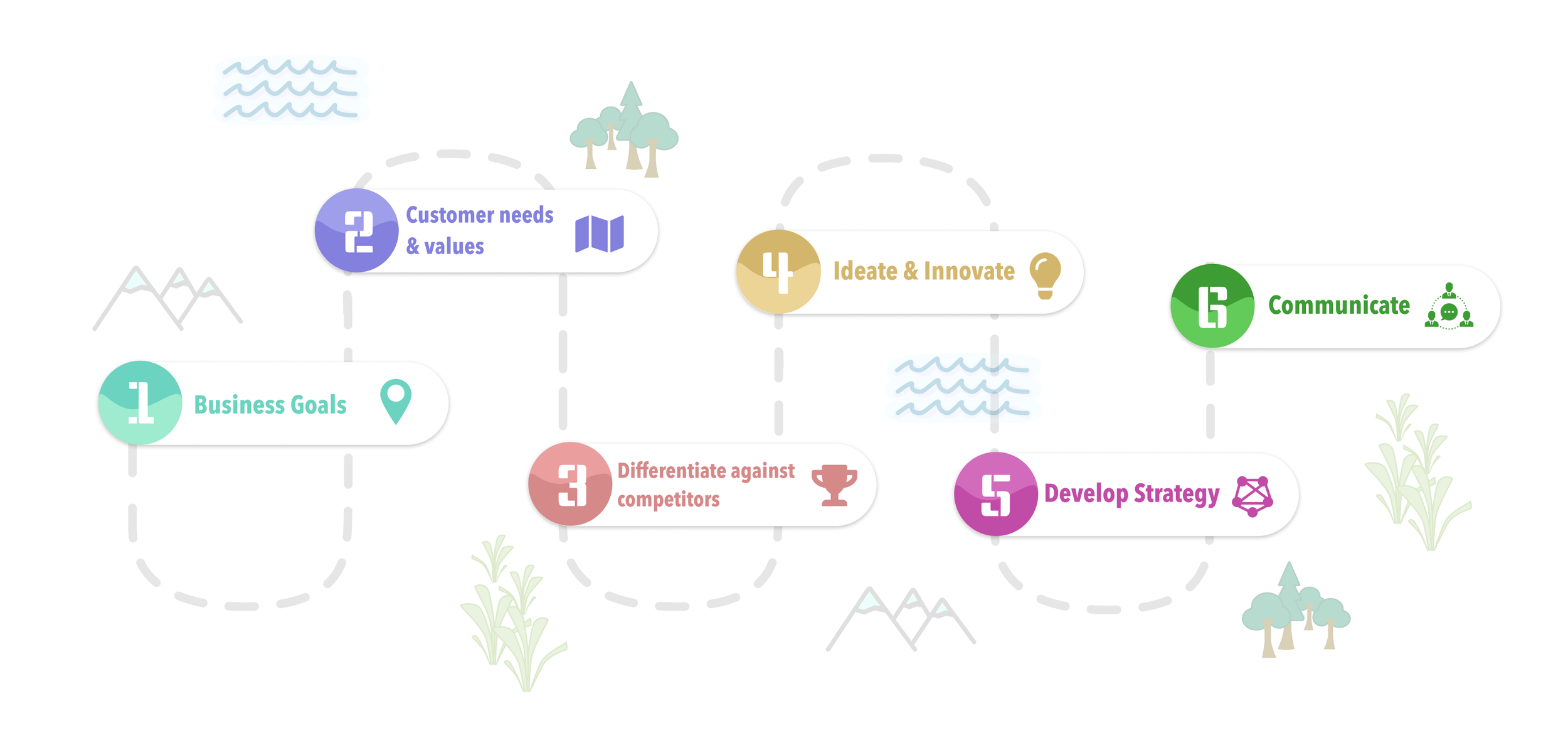6 Steps: How to Define an Experience Strategy:
These six steps were created to get you or your company started on the “how” to begin creating your Experience Strategy. If you want to understand more about the “why” it’s important to define an Experience Strategy take a couple of minutes to read “With No Experience Strategy you could be missing 70% of your market.”
Step One: Align to Company priorities
How well is the business aligned with how customers experience your brand?
The first step is to establish—or align on—a “Shared Vision.” This vision acts as a clear representation of the destination that everyone in the company can visualize and rally behind. It helps align priorities across the organization to ensure everyone is working toward the same goals.
Step Two: Align to customer needs and values
How well do you know your customers/users and what they value?
Determine the needs, wants, and behaviors of the prioritized customer segments, and develop an overarching approach, concept, or big idea that serves as a guiding theme for all design work.
Example Methods, Tools & Artifacts:
Customer Modal by Segmentation
Customer Experience Map
Customer Personas
Interaction models, purchase models
Customer Video Highlights
Customer journey maps, mental models
Ecosystem experience strategy
Feature set recommendations, concepts, designs
Feature roadmap, release plan
Interaction design, wireframes, templates
Metrics scorecard for benchmarking
Understanding your customers and users starts with asking the right questions, followed by selecting the appropriate tools from the designer’s toolkit. Depending on the research questions that need answering, you choose the most suitable method or tool for the job. Always remember, success doesn’t come from the tools themselves, but from how effectively the tools help uncover answers that move the company toward its goals.
Step 3: Differentiate against competitors
What set of activities delivers value to your customers/users that is sustainable and different?
Understanding the competitive landscape of your immediate competitors is crucial, but recognizing the non-obvious threats is even more important.
Differentiate your company’s products and services from key competitors by providing a roadmap that outlines how future releases will progressively achieve measurable goals aligned with your Shared Vision.
Steps to Differentiate from Competitors:
Define a competitive set of factors relevant to your business and customer experience.
Identify high-value tasks corresponding to areas of your Experience Map.
Assess and rate competitors’ experiences from the perspective of your most valuable customer archetypes or personas.
Identify experience design components that uniquely meet your customers’ needs and evaluate their inclusion in your roadmap.
Spot design approaches in competitors that surpass your own.
Communicate findings broadly using clear deliverables.
Update your competitive analysis regularly, at a frequency appropriate for your industry.
“New entrants, unencumbered by long-term history in the industry, can often more easily perceive the potential for a new way of competing. Unlike incumbents, newcomers can be more flexible because they face no trade-offs with the existing activities.”
-Michael Porter
Step 4: Ideate and Innovate
How safe is it for people at our company to inquire, think creatively, and de-risk innovation?
Begin by cultivating a culture that encourages healthy dialogue, fostering constructive discussions. Follow a structured framework for innovative thinking, testing, and de-risking assumptions across your organization to drive sustainable change.
Some Philosophies and Methodologies:
Design Thinking
Growth Strategy
Lean UX
Agile
Systems Thinking
Game Storming
Creative Brainstorming
A skilled facilitator can design and lead workshops of various sizes that foster cross-functional collaboration, generate innovative ideas, and begin unlocking new ways to delight your customers and users.
Step 5: Develop Strategy
What is your company doing that is different from your rivals?
Step five can be summed up as Position & Pattern. There is a lot we can go into here, so I will cover some key concepts to generate a competitive advantage. Companies must invest in developing differentiated experience designs.
“The essence of strategy is the in the activities - choosing to perform activities differently or to perform different activities than rivals.”
- Micheal Porter
“Competitive strategy is about being different. It means deliberately choosing a different set of activities to deliver a unique mix of value… A company can outperform rivals only if it can establish a difference that it can preserve.”
-Michael Porter
Activities consist of everything companies do to provide value to their customers/users. “Activities” correlate to experience design touchpoints (i.e. digital business activities).
Key Strategy Concepts:
Value Proposition: Defines the unique value your company delivers to customers, often requiring new ways to segment the market.
Value Chain: The set of activities your organization performs to create value for customers.
Positioning / Competitive Differentiation: Involves performing different activities from rivals or performing similar activities in distinct ways to stand out.
Fit: Creating strategic fit within your ecosystem is crucial for competitive advantage and superior profitability. Ensuring that different parts of the ecosystem are consistent, reinforcing, and optimally orchestrated “locks out imitators by creating a chain as strong as its strongest link.” — Michael Porter
Trade-offs: A sustainable strategic position requires trade-offs, meaning focusing on some activities necessitates sacrificing others. “A strategic position is not sustainable unless there are trade-offs… a trade-off means that more of one thing requires less of another.” — Michael Porter
Experience Strategy orchestrates a coherent system of experience components, not just isolated interactions, creating competitive advantage through how these components fit and align to deliver real value to customers.
Step 6: Communicate the strategy
Find a concise and memorable way to tell the story that explains your strategy.
The most important aspect of communicating your strategy is making it a “shared” set of goals that everyone in the organization feels part of and clearly sees how it contributes to the “shared vision.” Strategies and visions often fail not because they are poorly planned, but because momentum is lost due to a focus on daily firefighting and misaligned priorities between company functions. Organizations must provide time for their people to step away from daily tasks, focus on the future, challenge the strategy, and, if necessary, modify the shared vision.
Artifacts and deliverables to help with the communication:
Explain and draw clear connections between how Experience Strategy produces business results.
Create a statement of overarching strategy
Define objectives and concepts to clarify strategy
Artifacts of customer model, personas, and quantification.
Map of the current experience with target opportunities, and pain points, along with a vision for a future state.
A Strategy scorecard with KPIs and metrics
A Feature roadmap
Conclusion
There are many reasons why an organization may lack a clear Experience Strategy, one of the main reasons being that defining one is challenging—especially if it has never been attempted before. These six steps can help you or your company begin the journey toward an Experience Strategy and communicate it effectively to guide design decisions that align with the strategy.
Experience Strategy can represent a new mindset for some companies and even require a significant cultural shift. However, adopting a long-term perspective and ensuring every function in the organization shares the same destination are crucial for sustainability. Please reach out to me for a copy of the six steps to help communicate them within your company. Your company needs an Experience Strategist
Thanks!








